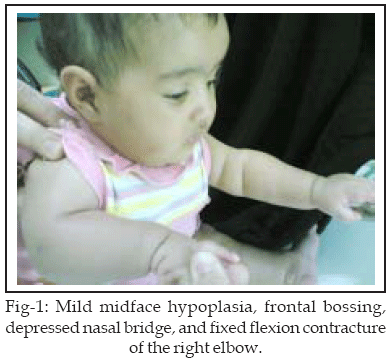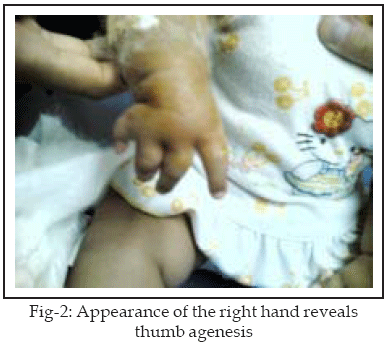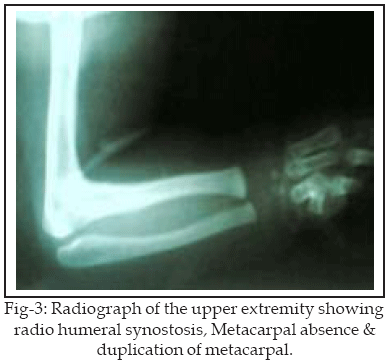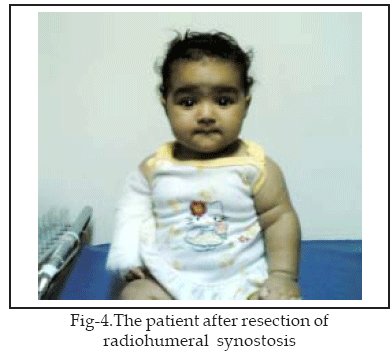|
|
||||
|
Published by : PROFESSIONAL MEDICAL PUBLICATIONS |
||||
|
ISSN 1681-715X |
||||
|
||||
|
- |
||||
|
CASE REPORT |
||||
|
- |
||||
|
Volume 25 |
July - September 2009 |
Number 4 |
||
|
|
||||
|
||||
|
|
||||
|
Published by : PROFESSIONAL MEDICAL PUBLICATIONS |
||||
|
ISSN 1681-715X |
||||
|
||||
|
- |
||||
|
CASE REPORT |
||||
|
- |
||||
|
Volume 25 |
July - September 2009 |
Number 4 |
||
|
|
||||
|
||||
The Antley-Bixler Syndrome: A Case Report and
Result of Radiohumeral Synostosis Resection
Seyed Abdolhossein Mehdinasab1, Nasser Sarrafan2, Omid Jangjoo3
ABSTRACT
Antley-Bixler syndrome (ABS) is a rare congenital disorder with multiple skeletal and cartilaginous anomalies that demand orthopedic management. In this report we address the diagnostic features and associated malformations of this syndrome and describe the functional outcome of resection of radio humeral synostosis in a 9 month old girl with Antley-Bixler Syndrome.
KEYWORDS: Antley-Bixler syndrome, Radiohomeral synostosis, Craniosynostosis.
Pak J Med Sci July - September 2009 Vol. 25 No. 4 686-688
How to cite this article:
Mehdinasab SA, Sarrafan N, Jangjoo O. The Antley-Bixler Syndrome: A Case Report and Result of Radiohumeral Synostosis Resection. Pak J Med Sci 2009;25(4):686-688.
1. Seyed Abdolhossein Mehdinasab,
2. Nasser Sarrafan,
1,2: Associated Professor of Orthopedic Surgery,
3. Omid Jangjoo,
Orthopedic Resident,
1-3: Emam Khomeini Hospital,
Jondishapur University of Medical Sciences,
Ahwaz, Iran.
Correspondence:
Dr. Seyed Abdolhossein Mehdinasab
Emam Khomeini Hospital,
Jondishapur University of Medical Sciences,
Ahwaz, Iran.
E-mail: hmehdinasab@yahoo.com
* Received for Publication: April 29, 2009
* Accepted: June 29, 2009
INTRODUCTION
Antley-Bixler Syndrome (ABS) is a rare genetic disorder characterized by distinctive craniofacial and skeletal abnormalities.
1,2 It was first reported in 1974 by lachertz et al. and again in 1975 by antley and Bixler. However it was in 1977 that the term Antley-Bixler syndrome was designated to describe the constellation of findings. Over the years what is known as Antley-Bixler syndrome has also been published under the terms such as multisynostotic osteodysgenesis, acrocepholo-synankie, and trapezoidocephaly multiple synostosis syndromes.3Primary features of Antley-Bixler syndrome includes craniosynostosis, midface hypoplasia with or without choanal stenosis or atresia, radio humeral synostosis, femoral bowing and joint contractures.
2-4 Cardiac, urogenital and gastrointestinal anomalies have also been reported including septal defect, hydronephrosis, and fused labial minored and anal artesian.3,5 Genital anomalies including fused labia minored, reported as well.2,6Hosalker Review of literature reveals that 41 cases of ABS have been reported so far.
5 Here we report a female patient with skeletal features of ABS and sort term result of radio humeral synostosis resection in that patient.Case History: A nine month old girl, born to a 23- year-old primigravida mother, presented with flexion contracture of right elbow. Her general health was good. The parents were unrelated and family history was not contributory. The pregnancy was uneventful and the baby was a product of normal vaginal delivery at 38th week of gestation. On physical examination, there was evidence of mild brachycephaly (cephalic index: 82), mild midface hypoplasia, frontal bossing and depressed nasal bridge, (Fig-1,2).


Examination of limbs revealed fixed 90 deg flexion contracture of the right elbow and absence of the thumb. Radiographs confirmed right radio humeral synostosis and skeletal abnormality of right hand including absence of 1st metacarp with hypoplasia and fusion of the 4 th-5th metacarp. (Fig-2,3).


Skull X-Ray and computed tomographic scans confirmed synostosis of both coronal sutures. Sonography of abdominal pelvic and echocardiography was unremarkable. Following a routine pediatrician and preanaesthetic evaluation, she was brought to the operating room. Under general anesthesia with lateral approach, resection of radio humeral synostosis and interposition of local soft tissue was performed. Full range of motion of elbow was achieved (Fig-3,4). A posterior splint was applied and physiotherapy was initiated. The range of elbow and forearm motion was normal in follow up visit at 18 months after surgery.
DISCUSSION
The etiopathogenesis of ABS is not clearly recognized. This Syndrome is suggested by most authors to be inherited as an autosomal recessive trait; however it may also result from sporadic mutations especially in fibroblast growth factor 2 locus.
5,7 Mutations in the genes for Fibroblast growth Factor receptors (FGFRs) have been reported to be involved in some craiosynostosis syndromes such as Pfeiffer, Apert, cruzon and Jackson- weiss Syndromes.8Fibroblast growth factor 8 (FGF8) protein is probably a ligand for FGFR2, is androgenic, and is expressed in the developing central nervous system, face, limb, Kidneys and gonads.
4,9 It plays a key role in both midbrain and limb development and as both FGF8 and FGFR2 are located in chromosome 10q25q26, they may be involved in craniosynostosis.10Prognosis is guarded in infancy and childhood (59% death rate in the first decade of life), but improves with age. Respiratory distress secondary to choanal atresia or stenosis can be a serious factor for mortality.
2,5Synostosis frequently results in early orthopedic consult as fixed contracture of the affected joints and the surgeons should be aware of the frequent associations with this syndrome. Other orthopedic manifestations of Antley-Bixler Syndrome include femoral bowing, ulnar bowing, and camptodactyly, synostosis of tarsal and carpal bones, clubfoot, vertebral body anomalies and prenatal fracture.
5 Cohen pointed out that the combination of craniosynostosis and elbow ankylosis as the cardinal features in this syndrome.1Our patient had milder features of skull and facial anomalies in comparison to similar reported patients. Also she had brachydactly and thumb agenesis that to our knowledge has not been reported with this syndrome.
Our report describes an uneventful management of such a patient with respect to anesthesia and outcome of radio humeral synostosis resection. Although resection of radio humeral synostosis has not been encouraged in some reports in literature, we succeeded to achieve satisfactory range of motion of the elbow in our 18 month follow up of this patient after resection of the synostosis.
CONCLUSION
Varying bone and joint anomalies are seen with ABS that need orthopedic assessment. Our patient was without urogenital or cardiac disorder. The resection of radio humeral synostosis had a good result at least in a short term fallow up.
REFERENCES
1. Antley RM, Bixler D. X-Trapezoidocephaly, midfacial hypoplasia and cartilage abnormalities with multiple synostosis and skeletal fractures. Birth Defects 1975;11:397-401.
2. Roth C, Hinney B, Peter M, Steinberger D, Lakomek M. Features of Antley-Bixler syndrome in an infant born to a mother with pregnancy luteoma. Eur J Pediatr 2000;159:189-192.
3. Lebard SE, Andlisa J, Thiemann RN. Antley - Bixler syndrome: A case report and discussion. Pediatric Anaesthesia 1998;8:89-91.
4. Chun K, Siegel-Bartelt J, Chitayat D, Phillips J, Ray PN. FGFR2 mutation associated with clinical manifestations consistent with Antly-Bixler syndrome. Am J Med Genet 1998;77:219-24.
5. Hosalkar HS, Shah HS, Gujar PS, Shaw BA. The Antley-Bixler Syndrome: Two New Cases. J Postgraduate Medicine 2001;47(4):252-55.
6. Crisponi G, Porcu C, Piu ME Antley-Bixler syndrome: case report and review of the literature. Clin Dysmorphol 1997;6:61-8.
7. Roth C, Hinney B, Peter M, Steinberger D, Lakomek M. Feattures of Antley-Bixler syndrome in an infant born to a mother with pregnancy luteoma. Eur J Pediatric 2000;159-192.
8. Schaefer F, Anderson C, Can B, Say B. Novel mutation in the FGFR2 gene at the same codon as the Crouzon syndrome mutations in a severe Pfeiffer syndrome type 2 case. Am J Med Genet 1998;75:252-5.
9. Gemel J, Gorry M, Ehrich GD, Macarthur CA. Structure and sequence of human FGF8. Genomics 1996;35:253-57.
10. Cohen MM, Jr. FGFs/FGFRs and associated disorders. In: Epstein C J, Erickson RP, Wynshaw-Boris A. (eds.): Inborn Errors of Development. Chapter 33. New York: Oxford Univ. Press 2004;380-400.
HOME | SEARCH | CURRENT ISSUE | PAST ISSUES
Professional
Medical Publications
Room No. 522, 5th Floor, Panorama Centre
Building No. 2, P.O. Box 8766, Saddar, Karachi - Pakistan.
Phones : 5688791, 5689285 Fax : 5689860
pjms@pjms.com.pk